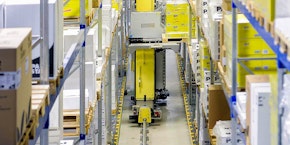When does automation in the warehouse make sense?
In the age of the industry standard 4.0, many companies have to think about logistics and warehouse automation. Every entrepreneur should first ask himself the questions "What do I expect from automation?" and "Does warehouse automation make sense to me? According to the Gabler Wirtschaftslexikon, the aim of an automated warehouse is "to increase the economic efficiency of warehousing by increasing stock turnover, reducing inventories and improving the utilisation of warehouse facilities, as well as shortening delivery times through faster retrieval. The prerequisite is an IT-supported warehouse management system (WMS) with interfaces to control the conveyor systems and to the materials management and/or ERP system".
Manual versus Automatic
In the intralogistics of companies, a distinction is usually made between manual and automated warehouses. Here the boundaries are fluid. There are also semi-automated warehouses. These use some of the automated warehouse solutions available on the market as well as a warehouse management system (WMS). There are no fixed standards for assessing whether a warehouse is automated or semi-automated. So the first question you should ask yourself is whether automation is needed at all. What are the advantages and disadvantages of a manual warehouse? When is it useful? A manual warehouse has several advantages:
· It can often be easily scaled. For example, temporary workers can be hired when seasonal peaks occur. It is therefore flexibly adaptable.
· The processes are often less complex, easier to understand and manage
· People are involved in the processes and can contribute their cognitive skills and practical experience.
· It is particularly suitable for a small assortment, a small number of goods, low storage capacity and unplanned expansion. Also an easy to carry out partial automation, e.g. by means of conveyor systems, is possible.
Disadvantages
· are, for example, the high costs caused by the use of people and the impairment of stock turnover or efficiency due to the loss of employees.
· More frequent errors, for example, during manual picking
The desire to improve order picking and avoid errors in order compilation is one of the reasons for partial automation, e.g. through automated guided vehicle systems (AGVs), or even a complete warehouse automation solution. Due to the improved efficiency of logistics, operating costs can be saved after automation, which means that the measure can be amortised after some time. In some sectors, such as the automotive industry, the degree of automation is already very high. Warehouse automation in a company has the following advantages and disadvantages:
Advantages:
· An automatic warehouse is cheaper to operate than a manual warehouse with a correspondingly high throughput, size and operating time (24/7).
· It is generally installed to save costs, reduce working hours, increase warehouse safety, minimize errors in order compilation and improve customer satisfaction.
· Due to the increasingly low availability of (skilled) personnel, automated warehouses are becoming more and more interesting.
Cons:
· Depending on the degree of automation, the investment can be quite high. However, due to the higher efficiency and savings in running costs, the automated warehouse can pay for itself after some time.
· Automation during ongoing plant operation presents a particular challenge. Careful planning is necessary to ensure a smooth transition.
· In many cases, processes can only be adapted by programmers who often do not have the best practical experience in logistics. Therefore the flexible adaptability to changed processes in the warehouse is limited.
· The scaling of an automatic warehouse is often difficult. The system is usually designed for seasonal peaks and is therefore not fully utilised during the rest of the year. This reduces cost efficiency.
Requirements for (partial) automation
Ideal conditions for warehouse automation are:
· Continuous operation (24/7) is planned wherever possible.
· The target processes must be clear and "validated".
· If possible, there should be no or very small seasonal fluctuations.
· There must be a long planning reliability with regard to the requirements on the storage facility (packages, lot sizes, throughput).
The more general conditions deviate from this "ideal automatic warehouse", the more flexible and manual processes should be integrated. However, there are increasingly warehouse solutions that offer some of the advantages of manual warehouses. With the Autostore system, these have scalability and adaptability to the physical warehouse structure. In addition, it offers a very high level of space utilisation and allows operators to take advantage of the cost efficiency of automation for smaller quantities. Shuttle warehouses (compact warehouses) are also easily scalable and flexibly expandable. The storage and retrieval capacity can be increased by adding more shuttles. In addition, small quantities and also types of articles can be stored efficiently in a non-selective way. In addition to scalability, an AGV also offers flexible adaptability to the material flow.
Conclusion
Automation will increasingly find its way into intralogistics. Drivers are not only the industry standard 4.0 and the required efficiency or cost minimization but even more so the future lack of qualified personnel. Here it is not always necessary to have a large complex fully automatic warehouse. Partial automation or small flexible solutions such as AGVs, shuttle systems or robots are increasingly the means of choice.


